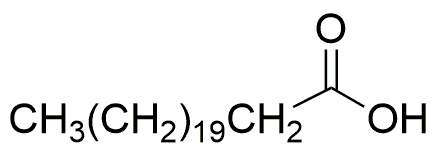Behenic acid is widely utilized in research focused on:
- Cosmetic Formulations: This fatty acid is a common ingredient in skin creams and lotions, providing emollient properties that help to soften and smooth the skin.
- Food Industry: Used as a food additive, behenic acid acts as a stabilizer and emulsifier, improving the texture and shelf-life of various food products.
- Pharmaceuticals: It serves as a lubricant in tablet formulations, enhancing the manufacturing process and ensuring consistent dosage in medications.
- Surfactants: Behenic acid is employed in the production of surfactants, which are essential in detergents and cleaning products for their ability to lower surface tension and improve cleaning efficiency.
- Biodegradable Plastics: It is being explored as a component in the development of biodegradable polymers, offering an eco-friendly alternative to traditional plastics.
General Information
Properties
Safety and Regulations
Applications
Behenic acid is widely utilized in research focused on:
- Cosmetic Formulations: This fatty acid is a common ingredient in skin creams and lotions, providing emollient properties that help to soften and smooth the skin.
- Food Industry: Used as a food additive, behenic acid acts as a stabilizer and emulsifier, improving the texture and shelf-life of various food products.
- Pharmaceuticals: It serves as a lubricant in tablet formulations, enhancing the manufacturing process and ensuring consistent dosage in medications.
- Surfactants: Behenic acid is employed in the production of surfactants, which are essential in detergents and cleaning products for their ability to lower surface tension and improve cleaning efficiency.
- Biodegradable Plastics: It is being explored as a component in the development of biodegradable polymers, offering an eco-friendly alternative to traditional plastics.
Documents
Safety Data Sheets (SDS)
The SDS provides comprehensive safety information on handling, storage, and disposal of the product.
Product Specification (PS)
The PS provides a comprehensive breakdown of the product’s properties, including chemical composition, physical state, purity, and storage requirements. It also details acceptable quality ranges and the product's intended applications.
Certificates of Analysis (COA)
Search for Certificates of Analysis (COA) by entering the products Lot Number. Lot and Batch Numbers can be found on a product’s label following the words ‘Lot’ or ‘Batch’.
*Catalog Number
*Lot Number
Certificates Of Origin (COO)
This COO confirms the country where the product was manufactured, and also details the materials and components used in it and whether it is derived from natural, synthetic, or other specific sources. This certificate may be required for customs, trade, and regulatory compliance.
*Catalog Number
*Lot Number
Safety Data Sheets (SDS)
The SDS provides comprehensive safety information on handling, storage, and disposal of the product.
DownloadProduct Specification (PS)
The PS provides a comprehensive breakdown of the product’s properties, including chemical composition, physical state, purity, and storage requirements. It also details acceptable quality ranges and the product's intended applications.
DownloadCertificates of Analysis (COA)
Search for Certificates of Analysis (COA) by entering the products Lot Number. Lot and Batch Numbers can be found on a product’s label following the words ‘Lot’ or ‘Batch’.
*Catalog Number
*Lot Number
Certificates Of Origin (COO)
This COO confirms the country where the product was manufactured, and also details the materials and components used in it and whether it is derived from natural, synthetic, or other specific sources. This certificate may be required for customs, trade, and regulatory compliance.

